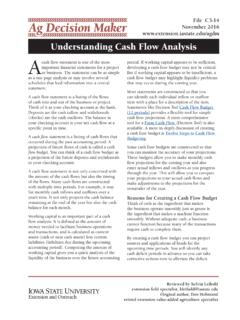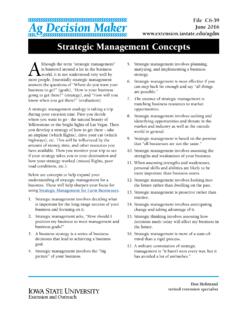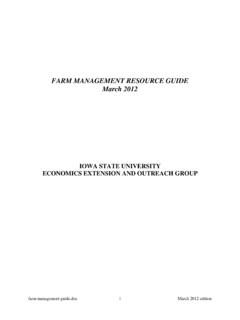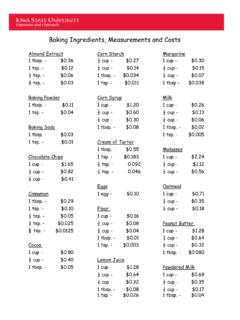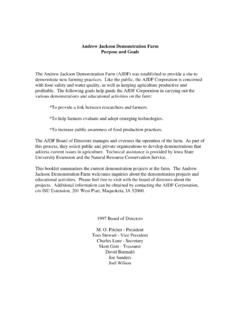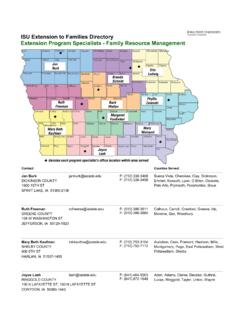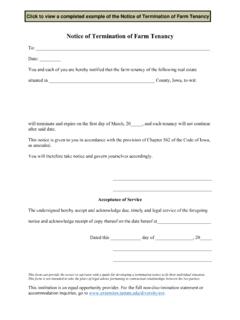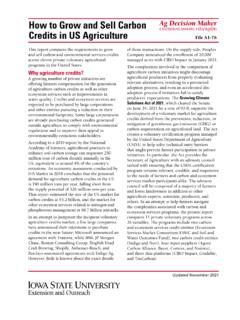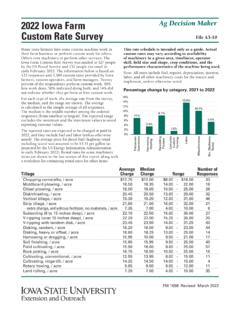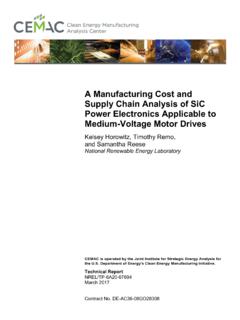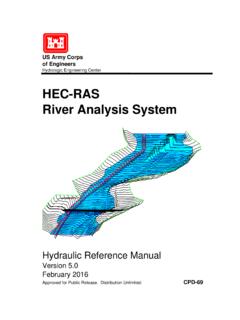Transcription of How do data and payments flow through ag carbon programs?
1 Updated April 19, 2022Ag Decision File A1-77 How Do Data and payments Flow through Ag carbon programs? The article Ag Decision Maker File A1-76, How to Grow and Sell carbon in US Agriculture, , compares 11 voluntary carbon programs across two-dozen characteristics in a tabular form, providing valuable details to help farmers identify the programs they could benefit from. The present article abstracts somewhat from the details and presents a simplified description of how data, payments , and methods flow in voluntary carbon programs. The goal of this article is to help farmers, policymakers, and ag stakeholders understand who will have access to data on farm practices, who is the most likely buyer of carbon credits for each carbon program, who controls the methodology that will be used to translate farm practices into carbon credits, and who issues payments to program participants (farmers, project developers, carbon program, verifiers, registries, soil labs, and data platforms).
2 The analysis is presented in flowcharts, with arrows pointing in the direction that data, payments , methods, and carbon credits move within each carbon first of ten flowcharts describes a traditional carbon offset generation system, with the following nine showing voluntary carbon programs currently operating in the United It is important to understand the workings of the existing markets for carbon offsets before exploring the newer carbon programs. Readers are advised to pay particular attention to the traditional carbon offset generation section before focusing on the carbon program(s) of their interest.
3 A major difference between the traditional carbon offsets and the carbon credits generated in the newer, voluntary carbon programs resides in the potential gap on their perceived qualities. A carbon offset is considered a top-quality token for one metric ton of 1 The carbon programs by Nutrien and TruTerra described in AgDM File A1-76 are in early stages of protocol development. This report will be updated when more information becomes dioxide-equivalent greenhouse gases (CO2e) sequestered through practices that adhere to trusted protocols ensuring additionality and permanence, which are verified by an independent third party, certified, and registered with a unique serial number into a secure ledger called the registry.
4 The registry is typically linked to a network of registries that serve as a clearinghouse of information on carbon credits (issued, unsold, sold, and retired) to avoid duplications and enhance transparency. When an owner of a carbon offset uses it to compensate for emissions of CO2e somewhere else, the serial number is retired from the registry (and the transaction is transparent to the clearinghouse). A carbon credit may or may not be perceived as being of comparable quality to a carbon offset. If carbon credits are perceived as being of lower quality than carbon offsets, then they would tend to attract lower market prices than offsets do.
5 The perceived quality of carbon credits is expected to be higher when verification and issuance are external to the carbon project, and lower when those critical processes are internal to the carbon project. By illustrating whether verification and issuance are external or internal processes to the carbon program, the present analysis provides some basis to anticipate differences in the perceived qualities and resulting prices for agriculture carbon credits issued by different carbon Offset Generation There are multiple registries in the world (such as Gold Standard, Verra, American carbon Registry, and Climate Action Reserve)
6 Where US farmers could register, under unique serial numbers, carbon offsets generated via conservation practices implemented anywhere in the US. Once a farmer owns a serial number issued by a registry, they can sell the carbon offsets associated with that serial number to any potential buyer, including industries Page 2 How Do Data and payments Flow through Ag carbon programs? with regulated greenhouse gas (GHG) emissions targets and corporations committed to achieving net zero emissions. However, only top-quality carbon offsets will be of interest to regulated industries, requiring additionality, permanence, project design and implementation according to registry protocols, independent third-party verification, and in some cases additional approval by a regulatory body.
7 The California Cap-and-Trade program and the Regional Greenhouse Gas Initiative (RGGI) in the northeastern US are two compliance markets where some top quality carbon offsets could be sold. It typically takes several years from project design to carbon offset issuance, and farmers usually enroll the collaboration of project developers to navigate the process. Due to the scale of the projects and the time lag between implementation of practices and issuance of offsets by registries, most projects are financed through emission reduction purchase agreements (ERPAs), according to which an investor (usually a regulated company) purchases the right to own the serial number of the registered carbon offsets and makes front-loaded payments to project developers and farmers (see Figure 1).
8 Given the risks involved in financing these projects, the cost to investors of carbon offsets financed through ERPAs is much lower than the price of (issued) carbon offsets in the spot market. The investing corporation uses in its GHG accounting system the serial number from the registry to compensate its emissions and retires the credit (making it no longer available for resell). The corporation will also communicate the reduction of its GHGs footprint to customers, owners, and stakeholders through its environmental, social, and corporate governance (ESG) reports.
9 Farm production data is shared with project developers, independent verifiers, and registries. payments are distributed over the life of the 1. Traditional carbon Offset Generation Page 3 How Do Data and payments Flow through Ag carbon programs? Ecosystem Services Market Consortium (ESMC)ESMC finds investors to finance projects through ERPAs. Its methodology to translate agricultural practices into carbon credits is based on the DeNitrification-DeComposition (DNDC) model and the Operational Tillage Information System (OpTIS) model, which are publicly available.
10 ESMC s methodology is under review by the Gold Standard registry and SustainCERT. Project developers can be internal or external to ESMC. Practices implemented by farmers are independently verified by SustainCERT. Soil tests are mandatory at onset and every five years. The Gold Standard registry issues serial numbers for carbon credits to ESMC, which in turn transfers them to investors. Farm production data is shared with project developers, ESMC, SustainCERT, and the Gold Standard registry. payments to all actors in the process are distributed over the life of the 2.
